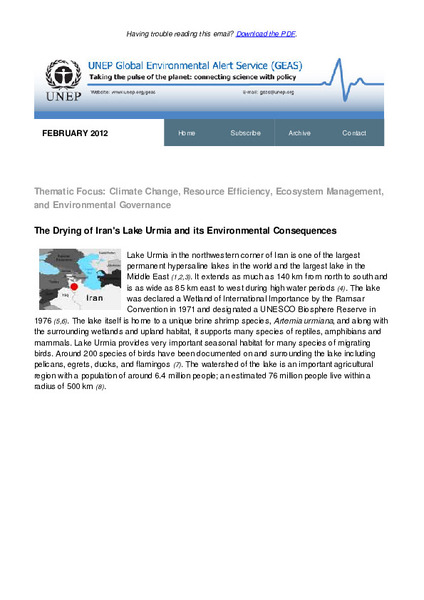| dc.contributor | Science Division | en_US |
| dc.contributor.author | United Nations Environment Programme | en_US |
| dc.coverage.spatial | Iran (Islamic Republic of) | en_US |
| dc.date.accessioned | 2022-10-20T10:23:09Z | |
| dc.date.available | 2022-10-20T10:23:09Z | |
| dc.date.issued | 2012-02 | |
| dc.identifier.uri | https://wedocs.unep.org/20.500.11822/40891 | |
| dc.description | Lake Urmia in the northwestern corner of Iran is one of the largest permanent hypersaline lakes in the world and the largest lake in the Middle East (1,2,3). It extends as much as 140 km from north to south and is as wide as 85 km east to west during high water periods (4). The lake was declared a Wetland of International Importance by the Ramsar Convention in 1971 and designated a UNESCO Biosphere Reserve in 1976 (5,6). The lake itself is home to a unique brine shrimp species, Artemia urmiana, and along with the surrounding wetlands and upland habitat, it supports many species of reptiles, amphibians and mammals. Lake Urmia provides very important seasonal habitat for many species of migrating birds. Around 200 species of birds have been documented on and surrounding the lake including pelicans, egrets, ducks, and flamingos (7). The watershed of the lake is an important agricultural region with a population of around 6.4 million people; an estimated 76 million people live within a radius of 500 km (8). | en_US |
| dc.format | Text | en_US |
| dc.language | English | en_US |
| dc.relation.ispartof | UNEP Global Environmental Alert Service (GEAS) | en_US |
| dc.rights | Public | en_US |
| dc.subject | lake | en_US |
| dc.subject | environmental degradation | en_US |
| dc.subject | natural resource | en_US |
| dc.title | The Drying of Iran's Lake Urmia and its Environmental Consequences - UNEP Global Environmental Alert Service (GEAS) February 2012 | en_US |


